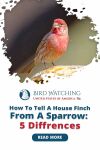
What’s This Post About?
Blue jays are large, beautiful songbirds. The bright blue shade on their feathers is eye-catching and can be spotted from a distance.
The blue jay is not entirely blue; it has shades of blue, black, and white on its body which adds to its attractiveness.
In this post, we will discuss the transitioning of a baby blue jay to an adult blue jay and why the blue jays adopt a bright blue color over time.
Is there scientific reasoning behind it? Read ahead to find out.
The blue found in blue jays comes from a pigment known as melanin which is a brown pigment. The trick to why we perceive the brown pigment as blue is because the modified cells found on the feathers scatter light. This scattering light emits a blue glow in every direction, making the bird appear blue.

What Are Blue Jays?
Blue jays are different from many other songbirds. Their blue color is what distinguishes them from the other birds. There are many interesting facts about blue jays, their habitat, and what they eat.

Description
Blue jays are native to North America and are famous for their bright blue coloration. They are 9 to 12 inches in length and weigh approximately 3.5 ounces.
If we talk about their appearance, they have a high blue crest on their heads and a blue plumage on their wings, crest, tail, and back.
Their face is usually white, and their underbelly comes off as a dull white tone.
Interesting Fact
Blue jays are curious birds and are known to play with aluminum foil and bottle caps when they are young.
They have a round black collar on their neck, and they also have a black spot on the front of their eyes.
One feature that makes the blue jays beautiful is the bar-like pattern on their wings, with shades of white, black, and blue on them.
Fun Fact
The crest on the blue jay’s head bristles outwards when they get frightened or aggressive.

Behavior
Blue jays are very defensive birds. They tend to protect their nests and usually live in small flocks. Some common predators that blue jays try to fight off are:
-
Eagles
-
Hawks
-
Raptors
Blue jays can mimic the sound of their predators and use it for safety.
They use these calls to check whether or not a certain predator is present in that area. If not, then it is safe for them to move in that direction.
These birds may also use these calls to trick other small birds. The noise can scare off others from the food source.
Pro-Tip
Do not go near a blue jay’s nest; they may attack you to protect themselves.
Habitat
Blue jays are often found in coniferous, deciduous, and mixed forests.
These birds are also frequent visitors of backyards across the central and eastern areas of the United States. At the time of migration, blue jays form flocks ranging from 5 to 250.
Blue jay’s migration is unpredictable; some migrate one year then stay in the same place for the following year. According to research, their migration depends on the food source and weather conditions.
Fun Fact
Young blue jays tend to migrate more than older blue jays.

Eating Habits
Blue jays are known to have strong bills. They prefer consuming hard nuts and seeds with their black bill. Other food items they like to eat are:
-
Corns
-
Berries
-
Grains
-
Insects
-
Peanuts
-
Acorns
Fun Fact
Blue jays eat eggs and nestlings of other birds, but rarely though.
What Species Belong to The Blue Jays Family?
There are a variety of species within the blue jays across different regions; read below for more insights.
Four subspecies belong to the blue jay family: Northern blue jay, Coastal blue jay, Interior blue jay, and Florida blue jay. These species range across different regions and may have certain differences in appearance, too.
The following table shares insights on the subspecies, where they are commonly found, and a short description to add to your knowledge.
| Subspecies | Common Name | Description | Distribution |
|---|---|---|---|
| Cyanocitta cristata bromia | Northern Blue Jay | Largest subspecies of blue jays with a dull plumage and pale coloring. | Northern US and Canada. |
| Cyanocitta cristata cyanotephra | Interior Blue Jay | Mid-sized subspecies with a dark blue mantle and a bright white underside. | Inland USA. |
| Cyanocitta cristata semplei | Florida Blue Jay | Smallest in the list with more greyish shades on the body. | Southern Florida. |
| Cyanocitta cristata cristata | Coastal Blue Jay | Mid-sized birds with vibrant blue color and thin body structure. | Coastal USA from North Carolina to Texas. |
Interesting Fact
The scientific name for ‘blue jays’ is cristata cristata.
Why Are Blue Jays Feathers Blue?
The bright blue coloring on the blue jays is due to a pigment known as melanin. Melanin is a brown pigment, but the light scattering creates a prism-like effect that makes humans see them as bright blue.

It is said that blue jays are not blue; instead, people are tricked into believing that they are.
If you notice other bright-colored birds, like cardinals that are bright red, they get their red plumage from a red pigment. However, there is no blue pigment found that may turn a bird’s feathers blue.
You can read more about the red pigment in this post.
Are Cardinals Born Red or Do They Turn Red? Interesting
Baby cardinals tend to change color as they grow. To find out about cardinals and their birth appearance, keep on reading.
The Coloration Process
The color in the feathers of blue jays comes from a pigment called melanin. The color is not blue; instead, it is brown. Humans perceive that brown pigment as blue due to the light scattering process.
A blue jay’s wings consist of tiny pockets that are made of keratin and air. When the light hits these pockets, all the wavelength colors except blue are absorbed.
The blue wavelength that is left is then refracted, which portrays the feathers as blue.

This optical illusion is created for all the birds that have a blue coloring, such as indigo bunting, mountain bluebirds, etc. To observe these bluebirds in your yard, you can invest in a pair of binoculars for a better view.
Occer 12x25 Compact Binoculars
This binocular has 12x magnification, 25mm objective lens and wide field of view, 273ft/1000yds
Fun Fact
The air and keratin found in the blue jay’s wings is the same kind of protein that builds up a human’s hair and nails.
Are Blue Jays Born Blue?
Blue jays, like other bright colored birds’ transition into different color phases. These phases are discussed ahead.
No. Just like many other songbirds, blue jays also go through a series of stages in their lifetime. Throughout these stages, they change colors before they finally reach the bright blue phase. These stages are eggs, nestlings, fledglings, and then adults.

Fun Fact
The oldest known blue jay lived up to 26 years and 11 months old.
Eggs
The female blue jay lays 3 to 7 eggs per nest. The eggs are of a mixture of blue, green, and yellow shades.
Eggs go through an incubation period of 17 days where the female is responsible for keeping the eggs warm, while the male blue jay brings in food and protects the nesting territory.

Pro-Tip
To attract blue jays to nest in your backyard, you can install bird feeders and provide nesting material for the birds.
Nestlings
When the babies come to life, they are born naked without any feathers. The baby blue jays are born with pink and black skin with tiny black hair on some patches.
Baby blue jays are born with their eyes closed; hence their parents are responsible for feeding and protecting them.
During the nestling stage, the baby’s eyes open, and they start gaining strength and tiny feathers.
Interesting Fact
Blue jays are omnivores and prefer food like insects, worms, dead mice, frogs, nuts, and seeds.
Fledglings
At this stage, the babies are about 18 to 21 days old. From this stage onwards, the babies are fed by their parents for another four to eight weeks.
Fledglings start developing blue feathers and look more like adult blue jays.
However, they do not yet develop a crested head, and their body color is more in a gray and white tone with less black or blue coloring. It is with time that they start to appear as bright blue.

Fun Fact
Blue jays are brown, not blue.
Keep Reading!
Blue jays are intelligent and beautiful songbirds with a unique textured body. This post covered all vital information about blue jays and the secret their cells hide about their blue coloration.
It is known by now that blue jays are not born blue; they grow brown feathers which, through the phenomenon of light scattering, makes us believe that they are blue.
If you are interested in reading more about the types of bluebirds found then do read this post.
16 Astounding Birds with Blue Heads with Pictures! (Backyard friendly)
Here is a list of blue-headed birds found commonly in the USA. The post consists of everything you should know about stunning bluebirds.

By David A. Swanson
Bird Watching USA
My name is David and I'm the the founder of Bird Watching USA! I started Bird Watching with My father-in-law many years ago, and I've become an addict to watching these beautiful creatures. I've learnt so much over about bird watching over the years that I want to share with the world everything I know about them!

David A. Swanson
Bird Watching USA
My name is David and I'm the the founder of Bird Watching USA! I started Bird Watching with My father-in-law many years ago, and I've become an addict to watching these beautiful creatures. I've learnt so much over about bird watching over the years that I want to share with the world everything I know about them!





![Ravens and Crows Size Comparison [23 Cool Pictures] Thumbnail](/assets/resized/img/posts/raven-vs-crow-size-100x150.jpg)
![7 Cute Duck Breeds with Yellow Ducklings [24 Pictures!] Thumbnail](/assets/resized/img/posts/yellow-duckling-breeds-100x150.jpg)

![Ravens and Crows Size Comparison [23 Cool Pictures] Thumbnail](/assets/resized/img/posts/raven-vs-crow-size_thumbnail-100x56.jpg)
![7 Cute Duck Breeds with Yellow Ducklings [24 Pictures!] Thumbnail](/assets/resized/img/posts/yellow-duckling-breeds_thumbnail-100x56.jpg)

